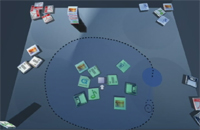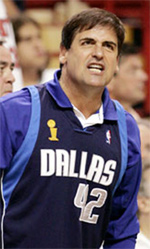 Every so often the urge surfaces to replace parts of GUI, like Menus, toolbars and the desktop. This popular demo of BumpTop, from the U of Toronto, goes after the desktop.
Every so often the urge surfaces to replace parts of GUI, like Menus, toolbars and the desktop. This popular demo of BumpTop, from the U of Toronto, goes after the desktop.
First, some history: Back on IE4 in 1996 and again on Neptune (and here) in 1999 we brainstormed, prototyped and evaluated all kinds of radical re-inventions of the desktop (and GUI systems). For a time it was our mission, and we tried, read, played with, or prototyped just about everything that had been done. The conclusion (at least mine): The desktop is a ghetto. People spend so little time there during their day that reinvention doesn’t buy you much.
Certainly not enough to deal with re-learning basic tasks. Unless your reinvention carries over to replace File.Open dialogs and their bretheren too, it’s a low mileage revolution. (Not to mention how you get web-apps to follow your new models too). Especially these days with better search and big storage, people don’t suffer much from their messy, poorly organized desktops. Any UI problems there are noise compared to, say, fighting with web-based e-mail apps or on-line banking sites.
One perenial mistake we made in the Windows group was thinking of System UI (Toolbars, desktops, file folders) as a primary place. We spent so much time trying to build the system as a good experience, when the best thing we could have done would have been to get out of the way (admitidly harder than it sounds). Even then, as now, it’s the web and apps that get 90% of people’s time in any OS.
Now, Bumptop: This is fine research work and a great demo. They got an amazing number of details and subtlties right. It is the desktop metaphor to the max: you can shuffle, flip-through, scale, and crumple, just like things on your real desktop.
It’s certainly cool, but what difference does it all make? It’d be easy to run a baseline usability study, and compare human performance with Bumptop vs. Mac or Windows (A note to anyone else doing other GUI reinventions). Does all the visualization and pile manipulation speed finding things? For newbies or for experts? Who knows, but it’d be easy to find out and would cut the hype.
Even if it does – how much time a day do you spend organizing stuff into folders? If you’re like me, as little as possible. I clean things up when it gets too messy, but generally I avoid my desktop, or any file/folder/maintance, as much as possible.
If you do watch the video and get bored, skip to 3:00 in – more advanced manipulations including stuff I hadn’t seen before. If this stuff floats your boat, check out the Data mountain project from MSR, or Maya’s DEC project. There are tons of other visualization projects from the last 2 decades, but I’m too lazy to dig them all up for this post :)
(And now, since it’s 3pm in the peak of summer in Seattle, I’m going to get as far away from desktops as possible, and go outside to play with the dog – you should too).


 The basic rule for managers who are trying to “build morale” or “team build” is this: any event outside of work does not create morale.
The basic rule for managers who are trying to “build morale” or “team build” is this: any event outside of work does not create morale. Where do you draw the line for passion?
Where do you draw the line for passion? But the problem is how those emotions are translated into behavior. Cuban complains, vents, rants and draws more negative attention to himself as if working only from the
But the problem is how those emotions are translated into behavior. Cuban complains, vents, rants and draws more negative attention to himself as if working only from the  Every now and then I’ve seen airport arrivals boards showing only the blue screen of death – This time it was somewhere new. I walked past about 10 gates to find the arcade, only to find new evils lurking inside those tall 1980s style video games.
Every now and then I’ve seen airport arrivals boards showing only the blue screen of death – This time it was somewhere new. I walked past about 10 gates to find the arcade, only to find new evils lurking inside those tall 1980s style video games. I guess at least in this case it’s obvious things are broken – with those autodetect things, trying oh so hard to be smart, you never know if you’re doing something wrong, if they’re broken, or just teasing you.
I guess at least in this case it’s obvious things are broken – with those autodetect things, trying oh so hard to be smart, you never know if you’re doing something wrong, if they’re broken, or just teasing you.
 I’m aware of the risks of stretching topics to the point of transparency, but I have to note the high quality of what’s happening in the NBA playoffs right now, at least from a team and management perspective. The best lessons I’ve learned about teamwork, leadership and success come from my experience in competitve sports – especially basketball. And right now some of the best basketball the NBA has seen in a long time is being played.
I’m aware of the risks of stretching topics to the point of transparency, but I have to note the high quality of what’s happening in the NBA playoffs right now, at least from a team and management perspective. The best lessons I’ve learned about teamwork, leadership and success come from my experience in competitve sports – especially basketball. And right now some of the best basketball the NBA has seen in a long time is being played.